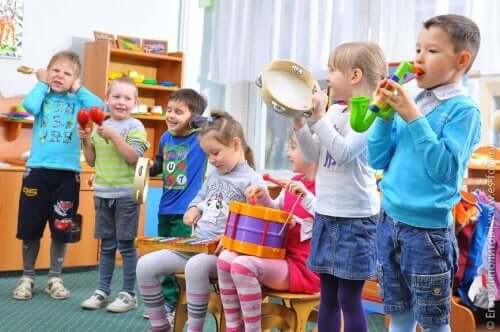How to Encourage Collaborative Play in Children

Collaborative play is a recreational activity that promotes teamwork. The intention is to achieve a common goal instead of focusing on competition. This didactic tool is great for educating with values in this time and age. Also, it’s an excellent way to promote strategies to develop social skills as adults.
Collaborative play
The concept of collaborative or cooperative play aims to be an alternative to competitive games with playful proposals developed in a relaxed, friendly environment. In them, all children can participate without exclusion or discrimination. Thus, each one of them can contribute to their unique skills.
As you can see, there are many benefits of collaborative play in children. In the short term, it helps give rise to a constructive educational environment. Plus, in the long term, it enhances positive social interaction skills.
Reasons to encourage collaborative play
1. It creates awareness, respect, and solidarity.

First, a collaborative game is based on the principles of respect and solidarity. Thus, it intends to instill awareness playfully to fight against discrimination. It can also be a strategy to prevent bullying.
Some schools are already adopting these types of techniques that invite children to empathize with their classmates. This way, they can put themselves in someone else’s shoes and figure out their options to solve challenges together.
Read also: How to Help Your Children Face Peer Pressure
2. Collaborative play is about cooperation and teamwork.
This kind of play integrates all participants and invites them to help each other. In fact, it’s essential to find a way to work as a team to solve a game. So, in no case can a child win individually, as it’s the case with many games because they all have an external element in common.
As you can see, children learn to value one another’s special skills and know when to use them. For example, if a child is good at math but not at sports then they won’t be excluded from the group for not being able to win a race. Instead, they’ll be in charge of some other task related to it.
3. It improves communication skills.

To solve the tests or challenges presented by a game, children must establish good communication with their peers. So, they practice how to express themselves and voice their opinions.
At the same time, they all learn to listen to one another. This strategy seeks to balance communication between children who seldom talk with those who constantly talk. Thus, there are equal opportunities for all.
Read also: Montessori Techniques that Can Help Handle Your Child’s Anger
4. Collaborative play teaches about conflict resolution.
Through play, children aren’t aware they’re learning to resolve conflicts.
The first step is to learn to express the need to resolve a conflict. So, they check the effectiveness of this strategy and then transport it to other situations in class or during recess. Likewise, they’ll learn to use this skill in their family environment and to their working environment when they become adults.
5. It instills self-confidence.

Finally, the collaborative play concept reinforces every child’s self-esteem and self-confidence. Through this activity, they learn to fulfill an essential function within a group to achieve a common objective. They may even discover talents they didn’t know they had after observing their peers.
Collaborative play is a great teaching tool to bring into an educational environment. Children are like sponges in that they absorb everything they see. Thus, they’ll integrate all of these values in a rather spontaneous and natural way.
All cited sources were thoroughly reviewed by our team to ensure their quality, reliability, currency, and validity. The bibliography of this article was considered reliable and of academic or scientific accuracy.
- Bay-Hinitz, A. K., Peterson, R. F., & Quilitch, H. R. (2006). Cooperative games: a way to modify aggressive and cooperative behaviors in young children. Journal of Applied Behavior Analysis. https://doi.org/10.1901/jaba.1994.27-435
- Creighton, S., & Szymkowiak, A. (2014). The Effects of Cooperative and Competitive Games on Classroom Interaction Frequencies. Procedia – Social and Behavioral Sciences. https://doi.org/10.1016/j.sbspro.2014.04.402
- Marker, A. M., & Staiano, A. E. (2014). Better Together: Outcomes of Cooperation Versus Competition in Social Exergaming. Games for Health Journal. https://doi.org/10.1089/g4h.2014.0066
This text is provided for informational purposes only and does not replace consultation with a professional. If in doubt, consult your specialist.








